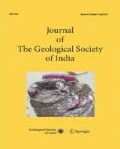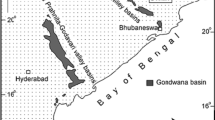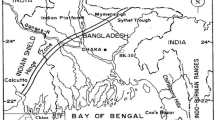Abstract
The early Permian Barakar coal measures Formation of Gondwana Supergroup in the Godavari basin comprise siliciclastic fluvial facies of passive continental margin. The lithofacies relationship and their sequences are analyzed quantitatively using embedded Markov Chain analysis along with improved binomial probability method. Summarized lithofacies sequence show the following order: (CGSD= Matrix supported conglomerate, gritty to pebbly/coarse-grained tabular and trough cross bedded sandstones)→(MGSD= Medium grained trough and planar cross bedded sandstones)→(FGSD= Fine-grained parallel and ripple drift cross-laminated sandstones)→(SH= Shale/inter-bedded sandstone-shale and gray shale)→(C=coal/shaly coal and carbonaceous shale)→(CGSD= Matrix supported conglomerate, gritty to pebbly/coarse-grained planar and trough bedded sandstones). These repetitive cycles accumulated in a low sinuosity, high gradient braided streams which became moderately sinuous at places. The lithofacies relationships showing fining upward tendency suggest a progressive upward decline in current competency. The sequence is considered as the classical example of a sand dominated braided river. The lateral changes in lithofacies association indicate shifting of sub-environments from stream channel, overbank levee and peat forming back swamp to flood plains of fluvial system. It is suggested that the channel wandering along with differential intra-basinal tectonism and subsidence controlled cyclic repetition during early Permian sedimentation in the Godavari basin.
Similar content being viewed by others
References
Allen, J.R.L. (1965) A review of the origin and characteristics of recent alluvial sediments. Sedimentology, v.5, pp.91–191.
Allen, J.R.L. (1986) Earthquake magnitude frequency, epicenter distance, and soft sedimentdeformation in sedimentary basins. Sediment. Geol., v.46, pp.67–75.
Billingsley, P. (1961) Statistical Methods in Chains. Annals Mathematical Statistics, v.32, 12p
Bowman, D.F. (2018) Principle of fluvial fan morphology. Springer, 148p.
Casshyap, S.M., and Tewari, R.C. (1988) Depositional models and tectonic evolution of Gondwana basins in peninsular India: In: B.S. Venkatachala and H. K. Maheshwari (Eds.), Concepts, Limits and Extension of Indian Gondwana. The Paleobotanist, v.36, pp.59–66.
Collinson, J., Mountney, N., and Thompson, D. (2006) Sedimentary Structures. 3rd Edition. Dunedin Academic Press, 302p.
Davis, J.C. (2002) Statistics and Data analysis. 3rdEdition. John Wiley Sons, New York, 637p.
DeCelles, P.G. Grat, M.B. Ridgway, K.D. Cole, R.B. Pivnik, D. A. Peruqa, N. and Srivastava, P., 1991. Controls on syn-orgenic alluvial fan architecture, Bear tooth Conglomerate (Paleocene), Wyoming and Montana. Sedimentology, v.38, pp.567–590.
Doveton, J.H. (1994) Theory and application of vertical variability measures and Markov chain analysis: In: J.M. Yarus and A. L. Chamberlain (Eds.), Computer Application in Geology, American Association of Petroleum Geology, pp.55–64.
Eidsvik, J. Mukerji, T. and Switzer, P. (2004) Estimation of geological attributes from well logs: an application of hidden Markov chains. Jour. Mathematical Geol., v.36, pp.379–398.
Elfeki, A. and Dekking, M. (2005) Modeling subsurface heterogeneity by couples Markov chains: Directional dependency, Walther’s Law and Entropy. Geotechnical Geological Engineering, v.23, pp.721–756.
Flores, R.M. (1981) Coal deposition in fluvial paleo-environments of the Paleocene Tongue River member of the Fort-union Formation, Powder River area, Wyoming and Montana. In: F.G. Ethridge and R.M. Flores (Eds.), Recent and ancient Non-Marine Depositional Environments; Models for exploration, SEPM Spec. Publ., no.31, pp.169–190.
Ghazi, S. and Mountney, N.P. (2009) Facies and architectural element analysis of a meandering fluvial succession: The Permian Warchha sandstone, Salt Range, Pakistan. Sedimentary Geol., v.221, pp.96–126.
Griffiths, J.C. (1967) Future trends on geo-mathematics. Pennsylvania State University Mineral Industries, v.35, pp.1–8.
Harper, C.W. (1984) Improved methods of facies sequence analysis. In: R. G. Walker (Ed) Facies Model 2ndEdition. Geological Association Canada, pp.11–13.
Hazzeldine, R.S. and Anderson, R. (1980) A braid plain facies model for the Westphalia B coal measures of NE England. Nature, v.284, pp.51–53.
Hota, R.N., and Maejima, W. (2004) Comparative study of cyclicity of lithofacies in Lower Gondwana formations of Talchir basin, Orissa, India: A statistical analysis of subsurface logs. Gondwana Res., v.7, pp.353–362.
Hota, R.N., Adhikari, P.C., Mohanty, A. and Maejima, W. (2012) Cyclic sedimentation of the Barakar formation, Singrauli Coalfield, India: Statistical assessment from borehole logs. Open Journal of Geology, v.2, pp.1–13.
Khan, Z.A. and Tewari, R.C. (2007) Quantitative model of Early Permian coal-bearing Barakar cycles from Son-Mahanadi and Koel-Damodar Gondwana coalfields of Eastern-Central India. Gondwana Geol. Magz., v.9, pp.115–125.
Khan, Z.A. and Tewari, R.C. (2010) R-mode factor analysis of lithologic variables from cyclically deposited late Paleozoic Barakar sediments in Singrauli basin. Jour. Asian Earth Sci., v.40, pp.144–149.
Khan, Z.A. and Tewari, R.C. (2012) Principle component analysis of lithologic variables in Early Permian Barakar coal measures, western Singrauli Gondwana sub-basin. Jour. Geol. Soc. India, v.79, pp.404–410.
Khan, Z.A. and Tewari, R.C. (2013) Geostatistical analysis of the Barakar cyclothems (EarlyPermian): A case study from the sub-surface logs in Singrauli Gondwana sub-basin of Central India. Internat. Jour. Geol. Earth and Environ. Sci., v.3, pp.1–22.
Khan, Z.A. and Tewari, R.C. (2017) Differential subsidence and coal formation in Early Permian Gondwana sequence of eastern-central peninsular India. Jour. Geosci. Res., v.2, pp.9–16.
Kulatilake, P.H.S.W. (1987) Modeling of cyclical stratigraphy using Markov chain. Internat. Jour. Min. Geol. Engg., v.5, pp.121–130.
Krumbein, W.C. and Dacey, M.F. (1969) Markov chains and embedded chains in Geology. Jour. Mathematical Geol., v.1, pp.79–96.
Malaza, N., Liu, K., and Zhao, B. (2013) Facies analysis and depositional environments of the Late Paleozoic coal bearing Madzaringwe Formation in the Tshipise-Pafuri basin, SouthAfrica. DOI: https://doi.org/10.1155/2013/120380.
McCabe, A.M. and Eyles, N. (1988) Sedimentology of an ice contact glaciomarine delta, Carey valley, Northern Ireland. Sedimentary Geol., v.59, pp.1–14.
McGowan, J.H. and Groat, C.G. (1971) Van Horn Sandstone, West Texas: an alluvial fan modelfor mineral exploration. Texas Bureau Economic Geology Report No. 72, 57p.
Miall, A.D. (1981) Alluvial sedimentary basins: Tectonic setting and basin architecture. In: A.D. Miall (Ed.) Sedimentation and Tectonics in alluvial basins. Geol. Assoc. Canada, Spec. Publ., v.23, pp.1–33.
Miall, A.D. (1996) The geology of fluvial deposits, sedimentary facies, basin analysis and Petroleum geology. Springer-Verlag, Berlin. 582p.
Miall, A.D. (2010) Alluvial deposits. In: N.P. James and R.W. Dalrymple (Eds.), Facies Model 4. Geol. Assoc. Canada, New Foundland, pp.105–137.
Miall, A.D. (2013) Principles of Sedimentary Basin analysis.3rd Edition. Springer Science Business. 605p.
Middleton, G. V. (1973) Johannes Walther’s Law of the correlation of facies. Bull. Geol. Soc Amer, v.84, pp.979–988.
Miller, S.M. (1983) A statistical method to evaluate homogeneity of structural populations. Jour. Mathematical Geol., v.15, pp.317–328.
Parks, K.P., Bentley, L.R. and Crowe, A.S. (2000) Capturing geological realism in stochastic simulations of rock systems with Markov statistics and simulated annealing. Jour. Sediment. Res., v.70, pp.803–813.
Rust, B.R. (1978) Depositional models for braided alluvium. In: A.D. Miall (Ed.), Fluvial Sedimentology. Mem. Canada Soc. Petroleum Geol., v.5, pp.605–625.
Saito, K., and Oguchi, T. (2005) Slope of alluvial fans in humid regions of Japan, Taiwan and the Philippines. Geomorphology, v.70, pp.147–162.
Sengupta, S.M. (2003) Gondwana sedimentation in the Pranhita Godavari Valley: A review. Jour. Asian Earth Sci., v.21, pp.633–642.
Sengupta, S. M. (2012) Introduction to Sedimentology. Anmol Publication, NewDelhi, 315p.
Smith, G.H.S., Ashworth, P. J., Best, J.L., and Simpson, C. (2006) The Sedimentology and alluvial architecture of the sandy braided south Saskatchewan River, Canada. Sedimentology, v.53, pp.413–434.
Soto, M.B. Duran, E.L. and Aldana, M. (2014) Stratigraphic columns modeling and cyclicity analysis of the Misoa Formation, Maracaibo Lake, Venezuela, using Markov chains. Geofisica Internacional, v.53, pp.277–288.
Tewari, R.C. (1998) Channel sandstone bodies in fluvial Permian-Triassic Gondwana succession of peninsular India. Jour. Geol. Soc. India, v.51, pp.747–754.
Tewari, R.C. (2008) Net subsidence and evolutionofcoalswamps in Early Permian coal measures of eastern India Gondwana basins using principal component analysis. Jour. Geosciences, v.51, pp.27–34.
Tewari, R.C. and Singh, D.P. (2008) Permian Gondwana Paleocurrent in Bellampallicoal-belt of Godavari valley basin, Andhra Pradesh and Paleogeographic implications. Jour. Geol. Soc. India, v.71, pp.266–270.
Tewari, R.C., Singh, D.P., and Khan, Z.A. (2009) Application of Markov chain and Entropy analysis to the lithologic succession-An example from Bellampalli coalfield, Andhra Pradesh, India. Jour. Earth Sci. System, v.118, pp.583–596.
Tita, D.E., and Djomeni, A. L. (2016) Application of Markov chain and Entropy analysis to lithologic successions-An example from the post-rift Cretaceous and Tertiary Formations, Kombe-Nsepe area, Douala sub-basin, Cameroon. Internat. Jour. Scienti. Res., v.6, pp.692–709
Walker, R.G. (1984) General Introduction: Facies, facies sequence and facies model. In: R.G. Walker (Ed) Facies Model. 2nd Edition. Geosciences, Canada, pp.1–9.
Walker, R.G. (1990) Facies modeling and sequence stratigraphy. Jour. Sediment. Petrol., v.60, pp.777–786.
Weckwerth, O. (2011) Paleoslope of Weichselian sand-bed braided rivers in the Torun Basin (Poland): results of a paleohydrualic analysis. Geologos, v.17, pp.227–238.
Xu, H., and MacCarthy, I.A.J. (1998) Markov chain analysis of vertical facies sequences using a computer software package (SAVFS): Courtmacsherry Formation, Southern Ireland. Computer and Geosciences, v.24, pp.131–139.
Yeganeh, B.Y., Feiznia, S. and VanLoo, A.J. (2012) Sedimentary environment and paleogeography of the Paleocene-Middle Eocene Kashkan Formation, Zagros fold-thrust belt, SW Iran. Geologos, v.18, pp.13–36.
Acknowledgements
The borehole logs used in this research were collected during our regional field study project of Godavari valley Gondwana basin in 2006–2008. We are extremely thankful to the Colliery Administration of Singareni Collieries Company Limited (SCCL), Kothagudam, Andhra Pradesh especially Sri Vassava Chari, the than General Manager (Exploration) for providing large number of bore log profiles and permitting us to use these logs for research purpose. One of us (RCT) thanks G Uday Bhaskar, the then Geophysicist of SCCL for local hospitality.
Author information
Authors and Affiliations
Corresponding author
Rights and permissions
About this article
Cite this article
Khan, Z.A., Tewari, R.C. & Hota, R.N. Facies Analysis, Markov Model and Linking of Sub-environments in the Early Permian Barakar Coal Measures of Godavari Gondwana Basin of Southeastern India. J Geol Soc India 95, 599–608 (2020). https://doi.org/10.1007/s12594-020-1486-0
Received:
Accepted:
Published:
Issue Date:
DOI: https://doi.org/10.1007/s12594-020-1486-0




